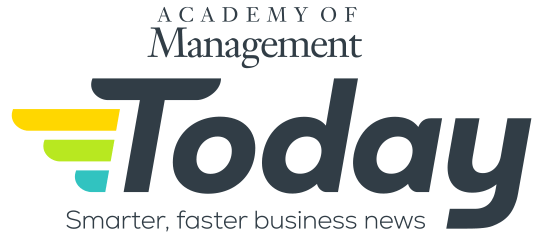By Daniel Butcher
As a greater number of managers take on more responsibilities that organizations used to assign to human-resources staff, many could benefit from training so that they can improve the experience of candidates and new hires during the interviewing and onboarding processes.
Academy of Management Scholar Carol Kulik of the University of South Australia said that managers make a difference in virtually every stage of an employee’s life, from recruitment, interviewing, and onboarding to day-to-day work and performance management.
“As a result of the COVID pandemic, we moved so much of the recruiting process—interviewing, hiring, and onboarding—online, and we’re never going back because online is cheaper and easier,” Kulik said. “But as a result, employees aren’t getting the kind of onboarding experience that they used to get where they were in a cohort with other new employees and had a chance to ask questions face-to-face.
“So now that’s the responsibility of the line manager, to fill in the gaps to help the new employee form relationships and encourage them to be proactive,” she said. “Nobody’s thinking about how that line manager is going to develop those skills.”
Another example Kulik points to is at the other end of employees’ careers, when they are considering leaving the organization for another opportunity or retiring. Line managers’ actions at this point can make or break an organization’s retention efforts.
“We know from research that the final interaction that you have with your manager, that one event is more important in determining how you feel about the company than anything else that’s happened in your entire career history,” Kulik said. “And yet, line managers aren’t prepared for that moment when an employee says, ‘I’ve got another job opportunity; I’m leaving.’
“Nobody’s taught them how to respond when an employee comes in and says they’re leaving, and we really depend on line managers to make sure that employees leave their jobs with a good attitude toward the company,” she said. “We count on them to be ambassadors or alumni.”
Another example Kulik gives is managers’ role in diversity, equity, and inclusion (DEI). She has conducted research focusing on age and gender and how leaders make workplaces to be inclusive for a wide range of people.
“You can have the best DEI practices in the world, but it’s the individual line manager who has to enact those practices,” Kulik said. “Mature-age employees tell us that they come to their line managers when they need a very small accommodation, for example, changing their shift or changing the size of the packages that they’re loading.
“And they tell us again and again that their line managers aren’t very receptive,” she said. “Line managers are used to treating all the employees exactly the same way.
“There’s a whole range of activities where we can point to the line manager as the key variable.”
A sample of Kulik’s AOM research findings:
-
Daniel Butcher is a writer and the Managing Editor of AOM Today at the Academy of Management (AOM). Previously, he was a writer and the Finance Editor for Strategic Finance magazine and Management Accounting Quarterly, a scholarly journal, at the Institute of Management Accountants (IMA). Prior to that, he worked as a writer/editor at The Financial Times, including daily FT sister publications Ignites and FundFire, as well as Crain Communications’s InvestmentNews and Crain’s Wealth, eFinancialCareers, and Arizent’s Financial Planning, Re:Invent|Wealth, On Wall Street, Bank Investment Consultant, and Money Management Executive. He earned his bachelor’s degree from the University of Colorado Boulder and his master’s degree from New York University. You can reach him at dbutcher@aom.org or via LinkedIn.
View all posts
Tagged #EmployeeRetention #OnboardingSuccess #ManagerEffectiveness #WorkplaceEngagement, employee morale, interviewing, interviews, line managers, management, managers, middle managers, morale, onboarding, recruitment, retention
Up next....
Why It’s Important to Thank Helpful Coworkers
By Daniel Butcher
Even top performers can get into a funk a work, and workers who usually are willing to help coworkers can stop collaborating. Beyond standard strategies such as promotions and raises, cultivating a collaborative culture that gives credit where credit is due is crucial for motivating such talented, helpful employees.
Academy of Management Scholar Abbie Shipp of Texas Christian University, who coauthored an Academy of Management Review article on how “organizational citizenship behavior” changes over time with Jessica Methot of Rutgers University, David Lepak of the University of Massachusetts Amherst, and Wendy Boswell of Texas A&M University, said that people continuously craft identity narratives to tell evolving stories about themselves.
“The research on organizational citizenship behavior took this approach of ‘People either help colleagues or they don’t,’ not really viewing a longer-term perspective or asking questions such as, ‘What happens if I help all the time and then I get burnt out?’ or ‘What if something happens at work and changes my identity to where I help colleagues more or less often?’” Shipp said.
“We looked at the ways in which some different situations or life cues could change your trajectory of helping over time, and why,” she said. “In terms of practical takeaways, talk to people about their identities and why they help at work and what’s meaningful to them—but also assume that these will change, so keep those conversations going.
“If somebody is one of your top performers today, don’t assume that that would stick.”
There could be ebbs and flows and different events that could—and likely will—impact performance and citizenship behavior.
“When you take that temporal lens, you start to really ask a lot of different questions about, ‘When do people help? How does it change? Is that temporary or permanent?’ etc.,” Shipp said.
“This allows leaders to explore ways to boost the morale of top performers and helpers and encourage them to remain at the organization, continue performing well, and continue to help others, even when things change over time,” she said.
A sample of Shipp’sAOM research findings:
-
Daniel Butcher is a writer and the Managing Editor of AOM Today at the Academy of Management (AOM). Previously, he was a writer and the Finance Editor for Strategic Finance magazine and Management Accounting Quarterly, a scholarly journal, at the Institute of Management Accountants (IMA). Prior to that, he worked as a writer/editor at The Financial Times, including daily FT sister publications Ignites and FundFire, as well as Crain Communications’s InvestmentNews and Crain’s Wealth, eFinancialCareers, and Arizent’s Financial Planning, Re:Invent|Wealth, On Wall Street, Bank Investment Consultant, and Money Management Executive. He earned his bachelor’s degree from the University of Colorado Boulder and his master’s degree from New York University. You can reach him at dbutcher@aom.org or via LinkedIn.
View all posts
Up next....
Shadow Networks Foster Collaboration
By Daniel Butcher
People often collaborate with colleagues across departments in ways that benefit their organization, sometimes sparking inter-team creativity and productivity. Human resources (HR) can either kindle or pour cold water on those fires.
Academy of Management Scholar Jessica Methot of Rutgers University and the University of Exeter—who cowrote an Academy of Management Review article on this topic with Emily Rosado-Solomon of Babson College and David Allen of Texas Christian University and University of Warwick—said that managers routinely search for ways to foster collaboration and break down silos by rotating employees or creating cross-functional teams. Other effective tactics include fostering networks through company retreats or company-sponsored volunteer service among employees across departments.
“I’m really interested in the interactions and communication among employees in a way that is outside the formal organizational chart,” Methot said. “The functioning of the informal organization is often a shadow network behind the official organizational chart.
“We know that there’s a lot of dynamics that occur in the ways that people interact and communicate and build trust and develop friendships and gossip in organizations, and organizational leaders often try to prioritize building a climate or a culture where people are creating these types of networks, where they feel a sense of psychological safety and are comfortable sharing information and asking questions,” she said. “But they don’t often know exactly what HR policies are going are going to affect those networks, and how they’re going to affect those networks.
“It’s crucial to track and analyze how a formal HR policy impacts the informal infrastructure in an organization, how people are interacting with each other, whether they form mentoring relationships or developmental relationships with each other, and whether they form close friendships, even when they traditionally had only worked together as team members.”
A sample of Methot’s AOM research findings:
-
Daniel Butcher is a writer and the Managing Editor of AOM Today at the Academy of Management (AOM). Previously, he was a writer and the Finance Editor for Strategic Finance magazine and Management Accounting Quarterly, a scholarly journal, at the Institute of Management Accountants (IMA). Prior to that, he worked as a writer/editor at The Financial Times, including daily FT sister publications Ignites and FundFire, as well as Crain Communications’s InvestmentNews and Crain’s Wealth, eFinancialCareers, and Arizent’s Financial Planning, Re:Invent|Wealth, On Wall Street, Bank Investment Consultant, and Money Management Executive. He earned his bachelor’s degree from the University of Colorado Boulder and his master’s degree from New York University. You can reach him at dbutcher@aom.org or via LinkedIn.
View all posts
Up next....
Why Small Talk Is Social Glue at Work
By Daniel Butcher
Small talk is crucial for employees to bond with each other and form a cohesive organizational culture—and hybrid and even fully remote work arrangements don’t change that.
Academy of Management Scholar Jessica Methot of Rutgers University and the University of Exeter—who coauthored an Academy of Management Journal article on that topic with Emily Rosado-Solomon of Babson College, Patrick Downes of the University of Kansas, and Allison Gabriel of Purdue University—said that they collected the data about why and how small talk can be an effective method for employee bonding before the COVID-19 pandemic.
“A lot of the conclusions that we drew about the impact of small talk on employees were seemingly turned on their head when everyone started working remotely,” Methot said. “The questions people asked us were, ‘How do we do this if we’re working remotely? How do we reconstruct these work relationships if we can’t just bump into each other in the hallway?
“It was a great challenge for us to think through, “How did small talk change during Covid, and what does this look like now in the post-Covid age?” she said. “It is so prevalent that we wanted to understand what was happening in organizations: Was it good? Was it bad? Is this something that we should be encouraging? Do we have any control over it whatsoever?”
Small talk can be a polarizing topic. Some people love it, while others hate it.
“It’s also sometimes cultural, where having chit-chat feels superficial and condescending and unnecessary, where others feel as though, if you don’t chit-chat with them, you’re not even acknowledging their presence, and it’s rude,” Methot said. “It makes up a really large chunk—about one-third—of our conversations, and it’s the social glue of the workplace.
“Small talk with our colleagues is a social ritual that many of us had built into our days,” she said. “We come into the office; we greet people in the morning; we chat with coworkers to pass the time; we take a break to grab a coffee; we reenergize before getting back to work.
“We make small talk in transition periods—we have small talk before going into a meeting, before negotiations, before performance evaluations, and so we also use it to grease the wheels.”
A sample of Methot’s AOM research findings:
-
Daniel Butcher is a writer and the Managing Editor of AOM Today at the Academy of Management (AOM). Previously, he was a writer and the Finance Editor for Strategic Finance magazine and Management Accounting Quarterly, a scholarly journal, at the Institute of Management Accountants (IMA). Prior to that, he worked as a writer/editor at The Financial Times, including daily FT sister publications Ignites and FundFire, as well as Crain Communications’s InvestmentNews and Crain’s Wealth, eFinancialCareers, and Arizent’s Financial Planning, Re:Invent|Wealth, On Wall Street, Bank Investment Consultant, and Money Management Executive. He earned his bachelor’s degree from the University of Colorado Boulder and his master’s degree from New York University. You can reach him at dbutcher@aom.org or via LinkedIn.
View all posts
Up next....
For Candidates and New Hires, Fitting in Is as Crucial as Skills
By Daniel Butcher
It’s a best practice for organizations to identify both formal and informal employee networks, establish how networks could change, and identify the specific human-resources (HR) practices that could affect those different networks. All of that will affect employees’ collaboration, efficiency, and productivity.
Academy of Management Scholar Jessica Methot of Rutgers University and the University of Exeter—who cowrote an Academy of Management Review article on this topic with Emily Rosado-Solomon of Babson College and David Allen of Texas Christian University and University of Warwick—said it’s important to analyze how different HR practices, including recruitment priorities and tactics, may affect employee relationships.
“We know that organizations focus on different types of recruitment strategies; if we home in on this one type of recruitment strategy, what does that mean for the composition of employees’ networks?” Methot said. “If we select candidates based on certain competencies, what does that mean for people’s network size or who’s in that network?
“A lot of this was grounded in the idea that human-resource management traditionally has been really deeply rooted in the idea of human capital—individuals’ knowledge, skills, abilities, expertise, functional areas, training, etc.—and trying to hire the best people based on their human capital, trying to train our employees so they have the knowledge and skills that they need to do that job well, and managing performance based on that human capital,” she said. “How are they demonstrating those competencies and using those skills?
“If we adopt this particular HR practice, what does that mean for the types of people and how they’re interacting in the organization?”
Methot and research colleagues identified three different dimensions to describe the composition of a network.
“This is who is in your personal network—as an employee, how many people are in my personal network, and who are those people?” Methot said. “The configuration of the network is the pattern of relationships and the structure of the network connecting them.
“Is everyone in my community connected? Do they all know each other? Do they all share information? Or are we siloed or disconnected? Are there bottlenecks?” she said.
“The content of those relationships refers to the properties or the definition of those relationships, from workplace collaborator to friend, how strong those relationships are, the degree of trust between employees in a given network, and what they’re communicating about, ranging from small talk and work tasks to personal information and gossip.”
A sample of Methot’s AOM research findings:
-
Daniel Butcher is a writer and the Managing Editor of AOM Today at the Academy of Management (AOM). Previously, he was a writer and the Finance Editor for Strategic Finance magazine and Management Accounting Quarterly, a scholarly journal, at the Institute of Management Accountants (IMA). Prior to that, he worked as a writer/editor at The Financial Times, including daily FT sister publications Ignites and FundFire, as well as Crain Communications’s InvestmentNews and Crain’s Wealth, eFinancialCareers, and Arizent’s Financial Planning, Re:Invent|Wealth, On Wall Street, Bank Investment Consultant, and Money Management Executive. He earned his bachelor’s degree from the University of Colorado Boulder and his master’s degree from New York University. You can reach him at dbutcher@aom.org or via LinkedIn.
View all posts
Up next....
The Pros of Small Talk at Work Outweigh the Cons
By Daniel Butcher
While there is some evidence that employees who go overboard making small talk can be less productive, occasional nonwork chats with colleagues can boost workers’ sense of well-being, belonging, loyalty to their organization. It also improves teamwork.
Academy of Management Scholar Jessica Methot of Rutgers University and the University of Exeter—who cowrote an Academy of Management Journal article on that topic with Emily Rosado-Solomon of Babson College, Patrick Downes of the University of Kansas, and Allison Gabriel of Purdue University—said that they found that small talk increases employees’ morale and improves bonding and collaboration.
“Small talk eases transitions—we rarely begin a meeting or pop into someone else’s office without a little small talk, just to grease the wheels and ease into the work-related conversation, and it helps us move from one activity to another,” Methot said. “We have small talk before meetings, interviews, performance evaluation, sales pitches, and negotiations.
“It is this social ritual that helps us transition from one activity to another and sets the stage for building relationships,” she said. “At a very basic level, it simply shows that we recognize someone else’s presence—it’s an acknowledgement.
“It makes us feel better when someone waves to us and smiles or says hello or chats with us, and so it sets a positive tone to a relationship, and as we continue to do that over time with colleagues, we start to build a stronger sense of trust and potentially things like friendships.”
Why does small talk have these effects?
Methot and her coauthors found that on days people made more small talk than they normally would, they experienced a boost in mood and positive energy, which, in turn, increased their positive social behaviors.
“Small talk boosted the extent to which they went out of their way to help their colleagues, and it increased their well-being,” Methot said.
“It had these great positive spillover effects where just simply having more small talk than they normally would on a given day really elevated their affect, their energy, and the extent to which they were willing to go out of their way for their coworkers,” she said.
Small talk, however, does have downsides, at least from a boss’s perspective.
“On the other hand, we found it was distracting, so it wasn’t all positive,” Methot said. “If someone you know comes into your office and starts chatting with you while you’re really in the flow and you were focused on doing your work, it pulls your attention away from that.
“And so, it does create this sense of a time famine where people who engage in too much small talk might not have enough time to then finish all of their work, which can create a little bit of anxiety,” she said. “But for the most part, it is really positive.”
A sample of Methot’s AOM research findings:
-
Daniel Butcher is a writer and the Managing Editor of AOM Today at the Academy of Management (AOM). Previously, he was a writer and the Finance Editor for Strategic Finance magazine and Management Accounting Quarterly, a scholarly journal, at the Institute of Management Accountants (IMA). Prior to that, he worked as a writer/editor at The Financial Times, including daily FT sister publications Ignites and FundFire, as well as Crain Communications’s InvestmentNews and Crain’s Wealth, eFinancialCareers, and Arizent’s Financial Planning, Re:Invent|Wealth, On Wall Street, Bank Investment Consultant, and Money Management Executive. He earned his bachelor’s degree from the University of Colorado Boulder and his master’s degree from New York University. You can reach him at dbutcher@aom.org or via LinkedIn.
View all posts
Up next....
How Remote Work Changes Employee Interactions
By Daniel Butcher
Working from home, whether it’s two, three, or five days a week, has a profound impact on the ways that colleagues communicate with each other. While it does present challenges, it doesn’t necessarily have to be negative, as many leaders advocating for a full return to the office assume.
Academy of Management Scholar Jessica Methot of Rutgers University and the University of Exeter—who coauthored an Academy of Management Journal article on that topic with Emily Rosado-Solomon of Babson College, Patrick Downes of the University of Kansas, and Allison Gabriel of Purdue University—said that small talk is a simple way to reenergize during the work day.
How does that translate to a remote work environment?
“What are the implications of small talk when employees are working remotely? Maybe it doesn’t look the same in a remote work environment,” Methot said. “After interviewing people after the onset of the Covid-19 pandemic and running additional studies, we found that many characteristics of small talk, including its spontaneity or scriptedness, are really difficult to replicate in a virtual environment.
“Meetings conducted remotely are more transactional and intentional—they’re planned; they’re scheduled,” she said. “You’re not bumping into someone on Zoom, so you can’t recreate that spontaneous interaction like you would if you were collocated in an office; it feels more awkward.”
After many companies moved to a remote work arrangement, it took a while for people to adjust to interacting with people over video-conferencing platforms.
“When you join a Zoom call, you’ve got a group of people together all trying to have small talk,” Methot said. “People are interrupting each other, talking over each other, because it’s hard to create that same sense of being in the same place in the way that we would engage socially otherwise.
“Also, when we’re physically present in a conversation, it creates this sense of copresence, where people feel like they’re in the conversation together,” she said. “We’re in this bubble where we’re interacting together, and we can’t do that same thing on Zoom.
“We’re looking at our own reflection on the camera, and we’re thinking about things that are going on in the virtual meeting room with us, so it’s hard to focus in that same way.”
It’s also easier to read people when talking to them in person.
“When we’re talking to each other in the same place, there’s a natural transfer of energy,” Methot said. “We’re able to read each other’s emotions better, but that transfer of energy is eroded in a virtual environment.
“It’s harder to see how people are feeling, reacting, and thinking when we’re meeting remotely than when we’re talking face-to-face,” she said. “Also, when we’re on remote calls or virtual meetings, chit-chat just isn’t a priority.
“We’re all pressed for time; we’ve structured our workday and may be experiencing Zoom fatigue, so we’re not trying to drag out meetings for too long.”
A sample of Methot’s AOM research findings:
-
Daniel Butcher is a writer and the Managing Editor of AOM Today at the Academy of Management (AOM). Previously, he was a writer and the Finance Editor for Strategic Finance magazine and Management Accounting Quarterly, a scholarly journal, at the Institute of Management Accountants (IMA). Prior to that, he worked as a writer/editor at The Financial Times, including daily FT sister publications Ignites and FundFire, as well as Crain Communications’s InvestmentNews and Crain’s Wealth, eFinancialCareers, and Arizent’s Financial Planning, Re:Invent|Wealth, On Wall Street, Bank Investment Consultant, and Money Management Executive. He earned his bachelor’s degree from the University of Colorado Boulder and his master’s degree from New York University. You can reach him at dbutcher@aom.org or via LinkedIn.
View all posts
Up next....
The New World of Communication among Colleagues
By Daniel Butcher
Even though many companies require employees to be in the office two, three, or even five days a week, communication methods among coworkers haven’t gone back to the ways they were pre-pandemic … but that isn’t necessarily a negative.
Academy of Management Scholar Jessica Methot of Rutgers University and the University of Exeter said that employees’ communication styles don’t have to go back to how they were five or 10 years ago to be effective.
“A lot of the more agile organizations and agile employees were able to essentially develop better, more efficient ways of working that they didn’t really know existed or that they didn’t have access to previously,” Methot said.
“They don’t have to come back to the office and talk to each other in person at the end of every day—maybe weekly, or maybe just monthly—and they can continue to communicate over Slack, Zoom, or Teams, where they felt more comfortable and it was more efficient for them to communicate more openly,” she said.
The first step is understanding the changes with professional communication. Ask whether technology-mediated communication can enable sustainable success over the long term.
“If we can be successful by communicating via various channels, not just face-to-face , maybe we react to that in a way that is a little more flexible, but being very strategic and thoughtful,” Methot said. “It does take an all-hands-on-deck attitude—let’s understand what we’re doing and why we’re doing this.”
Leaders and managers who fail to listen to and take into account employees’ preferences for communication, which ties in to where and how they prefer to work, are likely to hurt morale and encounter resistance. Insisting on being in the office five days a week and always conducting face-to-face meetings, just like before the pandemic, isn’t likely to be popular or help with retention.
“I do think the pushback comes when senior leaders are saying, ‘We don’t care if what you were doing was working; we’re all going to come back into the office five days a week anyway,” Methot said.
“The goal would be to take stock of all of the mechanisms and processes that we might have developed during that time that could be really successful, taking those into account and seeing how we might be able to integrate those into our work ecosystem in a way that helps support some of the new practices that we might develop,” she said.
A sample of Methot’s AOM research findings:
-
Daniel Butcher is a writer and the Managing Editor of AOM Today at the Academy of Management (AOM). Previously, he was a writer and the Finance Editor for Strategic Finance magazine and Management Accounting Quarterly, a scholarly journal, at the Institute of Management Accountants (IMA). Prior to that, he worked as a writer/editor at The Financial Times, including daily FT sister publications Ignites and FundFire, as well as Crain Communications’s InvestmentNews and Crain’s Wealth, eFinancialCareers, and Arizent’s Financial Planning, Re:Invent|Wealth, On Wall Street, Bank Investment Consultant, and Money Management Executive. He earned his bachelor’s degree from the University of Colorado Boulder and his master’s degree from New York University. You can reach him at dbutcher@aom.org or via LinkedIn.
View all posts
Up next....
Building Work Relationships Remotely
By Daniel Butcher
Many organizations successfully transitioned from full-time office work to hybrid work schedules, but remote arrangements do have implications for team and department cohesiveness, bonding among colleagues, and organizational culture.
“When we consider how people build these relational identities with others, how they develop a way of interacting with someone else is crucial,” said Academy of Management Scholar Jessica Methot of Rutgers University and the University of Exeter. “Say I know that my boss isn’t a morning person, and so I wait 30 minutes before he comes into the office before I approach him with a question; we might not know that information about a new person who comes into the organization, either into our team as a direct report or as someone I’m reporting to.
“We have to learn those things over time as we’re interacting with them, but we don’t necessarily get that opportunity as often when we’re working remotely,” she said. “It’s possible and even likely that it’s harder to develop these relational identities and to build these networks if we don’t have a great understanding of the norms and the expectations and the social rituals with these other individuals who we only potentially see virtually or interacting over Slack or email.”
Methot worked with a clinical organization as a consultant during the Covid-19 pandemic. Employees had to continue visiting their clients face-to-face in the field, but they ended up withholding their daily office debrief.
“They would usually come back together at the end of the day in the office and debrief about each one of the clients to ensure that everything was okay, that they had the resources and support that they needed during Covid,” Methot said. “They did away with the daily debriefings in person and ended up switching to Slack and Zoom.
“They became so comfortable communicating over Slack that once they started coming back to the office again, they were sitting in the same office space in the same room still chatting with each other over Slack,” she said. “Even face-to-face, they were still messaging each other, and they became so reliant on that form of communication.
“They developed a more informal way of communicating and became more comfortable with each other in that way—they hadn’t readapted to the pre-pandemic norm of being with colleagues in person, and also found this technology-mediated communication really efficient.”
A sample of Methot’s AOM research findings:
-
Daniel Butcher is a writer and the Managing Editor of AOM Today at the Academy of Management (AOM). Previously, he was a writer and the Finance Editor for Strategic Finance magazine and Management Accounting Quarterly, a scholarly journal, at the Institute of Management Accountants (IMA). Prior to that, he worked as a writer/editor at The Financial Times, including daily FT sister publications Ignites and FundFire, as well as Crain Communications’s InvestmentNews and Crain’s Wealth, eFinancialCareers, and Arizent’s Financial Planning, Re:Invent|Wealth, On Wall Street, Bank Investment Consultant, and Money Management Executive. He earned his bachelor’s degree from the University of Colorado Boulder and his master’s degree from New York University. You can reach him at dbutcher@aom.org or via LinkedIn.
View all posts
Up next....
Avoid Disruptions When Hiring, Downsizing, and Promoting
By Daniel Butcher
Adding or subtracting people from a team or department—or promoting someone within it—can enhance or detract from chemistry among colleagues, the effectiveness of teamwork, and the cohesiveness of organizational networks.
Academy of Management Scholar Jessica Methot of Rutgers University and the University of Exeter—who cowrote an Academy of Management Review article on this topic with Emily Rosado-Solomon of Babson College and David Allen of Texas Christian University and University of Warwick—said that the ways that organizations function aren’t solely based on people’s skills.
“Our employees are connected to each other and they aren’t only using their own knowledge and skills to get their work done; they’re also relying on others,” Methot said. “They go to others for feedback, advice, guidance, information, or mentorship, and they’re using that, leveraging that information to do better, to do their work better.
“Working to understand what HR policies are going to impact those connections and those relationships between people will help us better understand how they then perform in their job,” she said. “Diving in a little more deeply also leads to understanding how some of these HR practices and decisions that organizations are making can break up those networks and disrupt those relationships.
“On the one hand, they can help their formation, but on the other hand, they can really mess things up.”
Managers who can better understand how different types of HR practices might change employees’ sense of how they interact with others are more effective. Employees who are aware of various organizational networks can focus their networking and relationship-building efforts more productively.
“People’s definition of their role, how they interact with other people, who they report to, and who are on their team get disrupted when different HR practices move those individuals to another team or department or a different role with more responsibilities,” Methot said. “Let’s say they make a promotion decision—I’ve been working with someone on a team; we have a really great working relationship.
“We’re also friends; we trust each other, and then that person gets promoted and a new person gets put in their place,” she said. “I now have to build a whole new identity for how I relate to this new person, and that takes a lot of mental effort to rebuild this relational identity, this way of interacting with other people with whom we work.”
A sample of Methot’s AOM research findings:
-
Daniel Butcher is a writer and the Managing Editor of AOM Today at the Academy of Management (AOM). Previously, he was a writer and the Finance Editor for Strategic Finance magazine and Management Accounting Quarterly, a scholarly journal, at the Institute of Management Accountants (IMA). Prior to that, he worked as a writer/editor at The Financial Times, including daily FT sister publications Ignites and FundFire, as well as Crain Communications’s InvestmentNews and Crain’s Wealth, eFinancialCareers, and Arizent’s Financial Planning, Re:Invent|Wealth, On Wall Street, Bank Investment Consultant, and Money Management Executive. He earned his bachelor’s degree from the University of Colorado Boulder and his master’s degree from New York University. You can reach him at dbutcher@aom.org or via LinkedIn.
View all posts
Up next....
Why Email Jokes Fail
By Daniel Butcher
Most people seem confident in their ability to get their point across in emails. Few realize that writing an email is actually a minefield, and common errors can blow up in the sender’s face.
Academy of Management Scholar Kris Byron of Georgia State University said it’s important to remember your audience, especially if you’re trying to be funny or ironic. She published a research article on this topic in Academy of Management Review.
“I would hope that the people who I communicate with the most know I’m a sarcastic person; I joke around a lot, but I still try to make sure that there’s little ways indicating that,” Byron said. “If I am joking around, I’ll try to make sure they know; I might even just say, ‘Of course, I’m just joking,’ or I’ll add a smiley face or another emoji just to make sure that people know that I’m joking it or being sarcastic.
Including humor, irony, or sarcasm in an email can be risky, especially for work-related messages. Depending on the stakes and how well you know the recipient, it may not be worth the risk of being misunderstood and potentially offending that person.
“If you don’t know a person really well and you’re sending them an email, then usually I would not even try to be sarcastic or funny, just because they don’t know you, and they don’t have a way to tell from your facial expression or tone of voice if you’re joking,” Byron said. “They don’t have the context or knowledge about you—they lack sufficient personalized information about you to know how to interpret it, and they might not appreciate your sense of humor.
“I get it: Everyone is not everyone else’s cup of tea, so you have to proceed with caution when making a joke or using sarcasm,” she said. “I do think that you want to be careful—if you don’t know someone, I would not try to attempt humor generally.
“That’s the big takeaway: Know your audience.”
-
Daniel Butcher is a writer and the Managing Editor of AOM Today at the Academy of Management (AOM). Previously, he was a writer and the Finance Editor for Strategic Finance magazine and Management Accounting Quarterly, a scholarly journal, at the Institute of Management Accountants (IMA). Prior to that, he worked as a writer/editor at The Financial Times, including daily FT sister publications Ignites and FundFire, as well as Crain Communications’s InvestmentNews and Crain’s Wealth, eFinancialCareers, and Arizent’s Financial Planning, Re:Invent|Wealth, On Wall Street, Bank Investment Consultant, and Money Management Executive. He earned his bachelor’s degree from the University of Colorado Boulder and his master’s degree from New York University. You can reach him at dbutcher@aom.org or via LinkedIn.
View all posts












